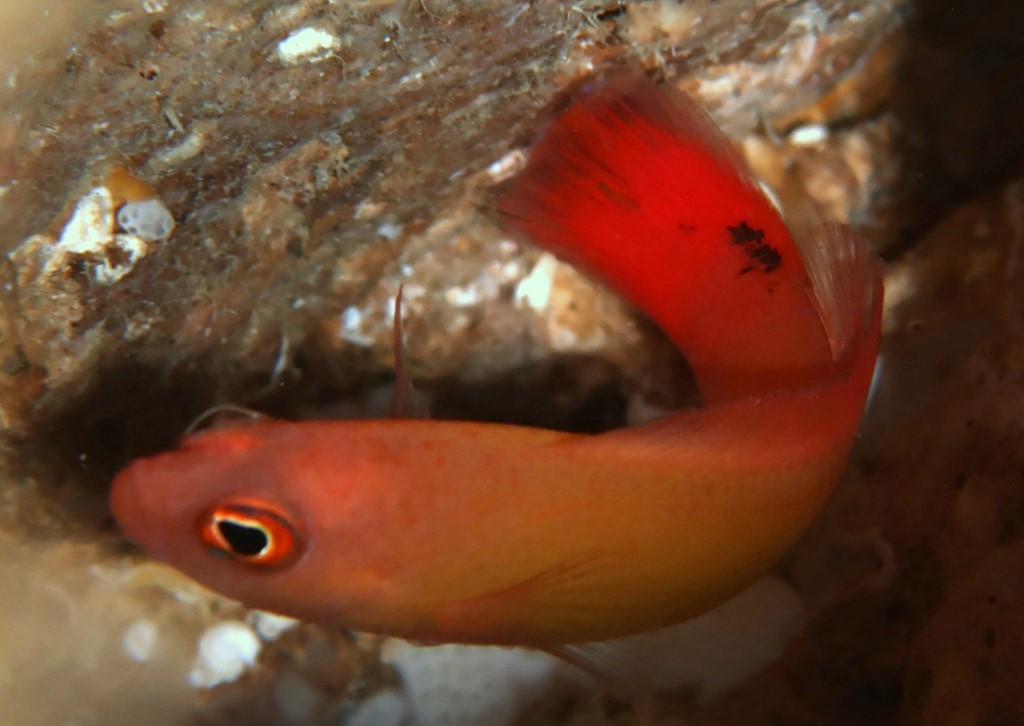PSEUDOCHROMIS JAMESI - (SCHULTZ, 1943)
Picture courtesy of: Alain Daoulas
Actinopterygii (Gigaclass) > Actinopteri (Class) > Teleostei (Subclass) > Blenniiformes (Order) > Pseudochromidae (Family) > Pseudochrominae (Subfamily) > Pseudochromis (Genus)
Spot-Tail Dottyback, Spot-Tailed Dottyback, 杰氏拟雀鲷,
Description
Dorsal spines (total): 3; Dorsal soft rays (total): 24-26; Anal spines: 3; Anal soft rays: 13-14; Pectoral fin rays: 18-20; Pelvic fin rays: I, 5. Scales in lateral series: 34-41; Anterior lateral line scales: 27-34; Posterior lateral line scales: 4-12 + 0-3; Circumpeduncular scales: 16; Gill rakers : 3-6 + 10-12 = 13-17; Predorsal scales: 14-18; Depth of body: 26.1-30.9 % of SL. Max. length: 5.5 cm TL. Depth range: 1 - 18 m.
Color
Male red color, shading to orange on head, breast and abdomen.
Female purplish grey color; Upper caudal fin base with black spot, broadly edged with white dorsally.
Etymology
Pseudochromis: from Greek, pseudes = false + from Greek, chroemo = to neigh. A name dating to Aristotle, referring to a drum (Sciaenidae) and its ability to make noise; Later applied to this damselfish and subsequently expanded to embrace dottybacks, cichlids and wrasses (all perch-like fishes once thought to be related).
jamesi: in honor of Schultz’ 12-year-old son, James, “who is interested in natural history”.
Original description: Pseudochromis jamesi Schultz, 1943 - Type locality: Reef of Rose Island, American Samoa.
Distribution
Western Pacific: Great Barrier Reef (Australia), Papua New Guinea, Solomon Islands to New Caledonia, Fiji, Tonga and Samoa.
Biology
Occurs inshore. Found on reef flats and on lagoon reefs. Aquarium fish.
Similar species
Pseudochromis kolythrus (Gill & Winterbottom, 1993) - Reported from New Caledonia.
Pseudochromis luteus (Aoyagi, 1943) - Reported from Western North Pacific: Philippines, Taiwan and Ryukyu Islands (southern Japan).
Last update: 22, May 2022
Actinopterygii (Gigaclass) > Actinopteri (Class) > Teleostei (Subclass) > Blenniiformes (Order) > Pseudochromidae (Family) > Pseudochrominae (Subfamily) > Pseudochromis (Genus)
Spot-Tail Dottyback, Spot-Tailed Dottyback, 杰氏拟雀鲷,
Description
Dorsal spines (total): 3; Dorsal soft rays (total): 24-26; Anal spines: 3; Anal soft rays: 13-14; Pectoral fin rays: 18-20; Pelvic fin rays: I, 5. Scales in lateral series: 34-41; Anterior lateral line scales: 27-34; Posterior lateral line scales: 4-12 + 0-3; Circumpeduncular scales: 16; Gill rakers : 3-6 + 10-12 = 13-17; Predorsal scales: 14-18; Depth of body: 26.1-30.9 % of SL. Max. length: 5.5 cm TL. Depth range: 1 - 18 m.
Color
Male red color, shading to orange on head, breast and abdomen.
Female purplish grey color; Upper caudal fin base with black spot, broadly edged with white dorsally.
Etymology
Pseudochromis: from Greek, pseudes = false + from Greek, chroemo = to neigh. A name dating to Aristotle, referring to a drum (Sciaenidae) and its ability to make noise; Later applied to this damselfish and subsequently expanded to embrace dottybacks, cichlids and wrasses (all perch-like fishes once thought to be related).
jamesi: in honor of Schultz’ 12-year-old son, James, “who is interested in natural history”.
Original description: Pseudochromis jamesi Schultz, 1943 - Type locality: Reef of Rose Island, American Samoa.
Distribution
Western Pacific: Great Barrier Reef (Australia), Papua New Guinea, Solomon Islands to New Caledonia, Fiji, Tonga and Samoa.
Biology
Occurs inshore. Found on reef flats and on lagoon reefs. Aquarium fish.
Similar species
Pseudochromis kolythrus (Gill & Winterbottom, 1993) - Reported from New Caledonia.
Pseudochromis luteus (Aoyagi, 1943) - Reported from Western North Pacific: Philippines, Taiwan and Ryukyu Islands (southern Japan).
Last update: 22, May 2022
